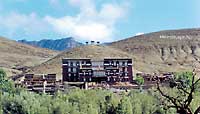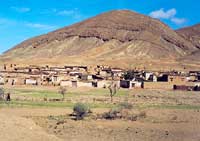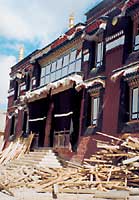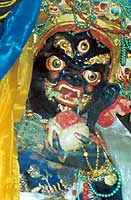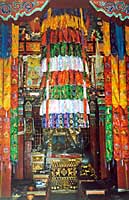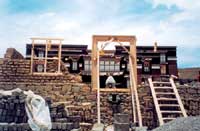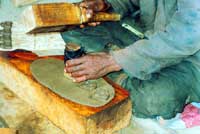|
|
||||
|
A
new monastery, a clinic and school: the villages that have returned to
life |
||||
|
Gangchen Monastery A view of the village The main entrance to the Monastery, still cluttered with building materials
A detail of the
A detail of the main prayer hall Work on the monk’s houses
The entrance to the Artists preparing long-life tsa-tsas |
by Sharon Dawson «The
journey from Kathmandu to Lhasa by road should be viewed as an
adventure, not a sightseeing tour by bus». This advice highlighted on
the tour agency depliant came into mind often during the three day bus
ride, which took our small group of adventurers this June from the
Kathmandu Valley to Tibet - the Roof of the World. The journey by road,
through one of the world’s highest and undoubtedly most stunning and
spectacular mountainous regions, although extremely uncomfortable, and
both physically and mentally demanding, is a journey that should be
undertaken at least one time by anyone who is interested in Tibet, the
Tibetan people and their culture. As
the bus struggled upwards along winding mountain passes, on roads that
literally disappeared before our eyes under slurry and rocks falling
from the mountains or transformed into virtually impassable mud - we
were able to witness at first hand the desperate living conditions of
those people populating the poorest and remotest area of Tibet. As
we passed the makeshift tents of the nomads, the small houses made of
mud and sticks, or passed the occasional herdsman driving small flocks
of sheep and goats - with the magnificent snow capped mountains
providing a constant and extremely beautiful backdrop - we all wondered
how these people actually managed to survive. Living at altitudes of up
to 5200 metres, with freezing temperatures (even in June which is not
the coldest season of the year) and with a parched and rocky terrain -
these people in fact live by farming. With everything, from the altitude
and weather to the land, going against them - young and old work side by
side trying to scrape together some kind of living from farming small
pieces of land. But, even this is only possible for a short period each
year, as people are forced to retreat into their homes during the long
harsh winter. In
these remote places it is normal for entire families to share a single
room or tent, without fuel for heating some families do not even have
blankets to bring them comfort during the freezing winter months. These
people survive without shops, schools, medical care, heating,
electricity, toilets, water and sometimes are unable to produce enough
food... Some families, facing particularly desperate conditions, are
forced to send their eldest children to the nearest town, or even as far
as Shigatse to earn money for the family by working on building sites or
road construction. Even when the bus stopped in what seemed the most
desolate places - with no houses in sight - children appeared almost
miraculously to stare at the strange visitors. With tiny spoons safely
hanging from strings around their necks and cloth bags slung across
their backs, they are actually searching for and collecting anything
that is worth taking home. From
Shigatse in Central Tibet, the country’s second largest city, it took
40 minutes by jeep to cover the 20 km necessary to reach our destination
of Gangchen Village. Leaving behind the bustling streets, restaurants
and hotels, as well as the golden roofs of Tashi Lumpo Monastery - the
surroundings all too quickly returned to the desolation and poverty we
saw during the first part of the journey from the border. We
got our first glimpse of Gangchen Monastery from the main road, but as
we neared the Monastery we were immediately struck by the impressive
size of the recently completed building (realised in wood, stone and
cement). Nearer still, we noted the colourful decorations, the white and
blue curtains hanging from the sculpted wooden door and window frames,
the golden coloured ornaments positioned on the roof, the prayer flags
flapping in the wind dispersing mantras in all directions. The
immediate surroundings of the Monastery were still a hive of activity
and bustled with life as, singing and laughing, more than 90 people were
still hard at work to realise the new accommodation for the monks. As
people continued to deliver and prepare the necessary materials, as
water was delivered for the construction work by trucks lined with
plastic sheets - the future outer courtyard of the Monastery will
continue to resemble a building site for some time.
“Just
40 minutes from Shigatse by jeep
From
the central steps leading up to the Monastery, we were able to see the
paintings decorating the walls of the entrance to the main assembly hall
- with remarkable skill artist monks from Tashi Lumpo Monastery have
beautifully reproduced traditional images which include the four
directional kings and the wheel of life. The recently finished prayer
hall, a true feast of colour and image for the senses, is now completely
adorned with paintings and statues of the most important divinities,
lineage masters and historical figures. The walls and columns are
painted and concealed behind fine brocades and thangkas (sacred
paintings on cloth). Ready to accommodate the monks for their prayer
sessions, traditional wooden tables and handwoven carpets were already
placed in rows in front of the intricately carved lama’s throne. To
the left of the main altar, a small prayer room has been dedicated to
the protector deities, and houses amongst others a particularly
beautiful statue of Palden Lhamo - a female deity who is considered to
be the special protectress of Gangchen. Some of the upstairs rooms on
the first floor were also near completion - a reception room and bedroom
- in preparation for the visit this summer of Lama Gangchen. From
the roof of the Monastery we were able to gain a complete picture of the
building work still in progress. Running parrallel with the sides of the
monastery (from the back to the front) a row of five smaller buildings
were already well underway. Following exactly the traditional Tibetan
style, some of the decorative wooden window frames and pillars have
already been put in place. The first four buildings, divided in half,
will each provide two houses for the monks who are presently living in
very squalid conditions. Each house divided into four rooms will provide
ample space for cooking, sleeping and studying. The
fifth building in the row will be utilised on one side as general office
space, and on the other side as a communal kitchen for use during
special ocassions and prayer ceremonies. Directly
facing the Monastery, running horizontally from where the two rows of
houses finish, another building is also well underway. This building
will offer eighteen rooms, that is nine on either side of the door which
will be the main entrance to the Monastery compound. From the roof we
could see how these new structures have created a square enclosed
internal courtyard. In the future, it is hoped by the monks that this
additional assembly space will be large enough to host the numerous
local people who have requested Lama Gangchen to give teachings during
his next visits to Tibet. It
is also the wish of all those living in Gangchen, that next year
permission will be given for new monks to join the monastery and the
nineteen monks presently living there.
With
the building of the
From
the Monastery, we visited the nearby medical clinic. In an area deprived
of primary healthcare structures for so long, the recently constructed
medical clinic is enjoying a great success amongst the local people.
Offering virtually the only medical aid in the area, the clinic is well
used by the inhabitants of Gangchen and all the nearby villages. The
doctor in traditional Tibetan medicine is also at the service of those
living in remote areas who are too sick to travel to the clinic. Three
people from the area, including one of the monks from Gangchen
Monastery, are currently in Shigatse receiving first aid and medical
training from the Red Cross to enhance the services of the clinic. Accompanied
by monks from the Monastery, we also visited the site destined to house
the retreat centre. The location is already indicated by a wall built to
enclose and protect the future centre. Trees donated by the local
government have also been planted at the site. The
area of Gangchen has literally been reborn in this past eighteen months,
and is once again full of life, activity and laughter. This «revitalisation»
is not solely due to the recent influx of financial or material aid to
the area, but can be attributed to something more basic. The rebuilding
of Gangchen Monastery, requested by the community to Lama Gangchen, has
given back to them something that in the past years they have been
missing - a heart. Just as a human body cannot function without the
life-giving organ, a Tibetan community cannot function without a
monastic structure. The presence of the Monastery guarantees to the
community help and advice, aid, education, healthcare, as well as
offering a social and spiritual focal point. |
|||
|
|
||||

